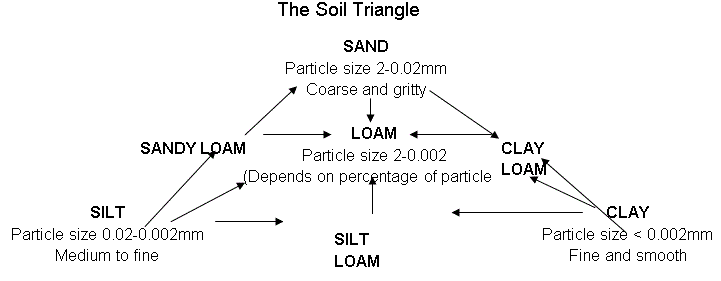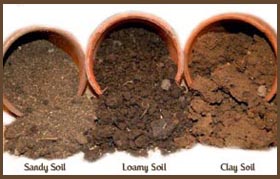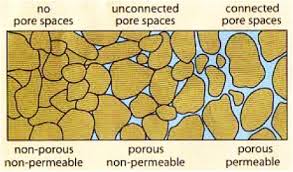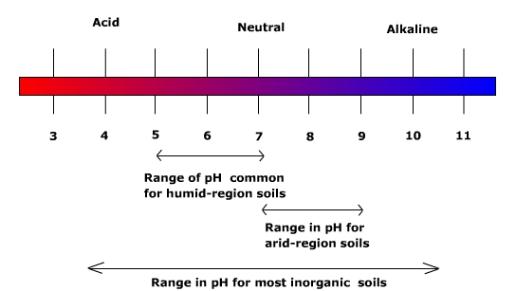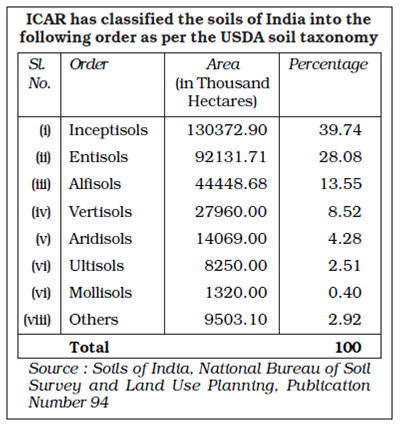Soil Characteristics
Knowing a soil’s water, mineral, and organic components and their proportions can help us determine its productivity and what the best use for that soil may be. Several soil properties that can be readily tested or examined are used to describe and differentiate soil types. The most important properties are discussed below:
1. Colour: A soil’s colour is generally related to its physical and chemical characteristics. E.g.
- Soils rich in humus tend to be dark because decomposed organic matter is black or brown. Soils with high humus content are usually very fertile, so dark brown or black soils are often referred to as ‘rich’. [Note – Some dark soils may be dark because of other soil forming factors and may have little or no humus]
- Red or yellow soils typically indicate the presence of iron.
2. Texture: The soil texture refers to the coarseness/fineness of the mineral matter in the soil. It is determined by the proportion of the sand, silt and clay particles:
- Clay: Particle Size – diameters less than 0.002 millimetre
- Silt: Particle Size – diameters between 0.002 millimetres to 0.05 millimetres.
- Sand: Particle Size – diameters between 0.05 and 2 millimetres.
[Rocks larger than 2 millimetres are regarded as pebbles, gravel, or rock fragments and technically are not soil particles.]
Note:
Clay being the finest of all plays the most important role in soil chemistry (offers more surface area).
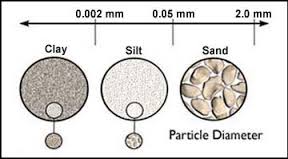 Source
Source
The proportions of each of these soil fractions determine soil texture and its properties.
Source
Source
The soil texture directly affects:
- The soil water content
- Water flow
- Retention of nutrients
- Extent of aeration
Loamy Soil: Loamy soil is the one in which none of the three (sand/silt/clay) dominates the other two. In particular, loamy soil has about 40% sand, 40%silt, and 20% clay.
Source
Note:
Generally speaking, Good Soils = Clay + Humus. The clay-humus complex is essential for a fertile soil as it provides it with a high water and nutrient holding capacity. Humus acts as a cement binding the soil particles together and thus reducing the risk of erosion.
3. Structure :
While the soil texture describes the size of soil particles, soil structure refers to the arrangement of the soil particles. The way in which sand, silt, clay and humus bond together is called soil structure. Structure can partially modify the effects of soil texture.
Some structural characteristics of soil:
- Permeability – The ease with which liquids/gases can pass through rocks or a layer of soil is called permeability. It depends on the size, shape and packing of particles. It is usually greatest in sandy soils and poor in clayey soils.
- Porosity – The volume of water which can be held within a soil is called its porosity. It is expressed as a ratio of volume of voids (pores) to the total volume of the material.
Source
- Note: Most porous rocks are permeable with the exception of clay in which pore spaces are so small that they are often sealed with groundwater held by surface tension. Another exception – granite is non-porous but permeable. It is a crystalline rock and hence non-porous. Its individual crystals absorb little or no water but the rock may have numerous joints/ cracks through which the water can pass rendering it permeable.
- A soil with high organic content also tends to have high porosity.
4. Soil Chemistry – Acidity or Alkalinity:
An important aspect of soil chemistry is acidity, alkalinity (baseness), or neutrality.
Low pH values indicate an acidic soil, and a high pH indicates alkaline conditions. Most complex plants grow only in the soils with levels between pH 4 and pH 10 but optimum pH varies with the plant species.
Source
- In arid and semi-arid regions, soils tend to be alkaline and soils in humid regions tend to be acidic.
- To correct soil alkalinity and to make the soil more productive, the soil can be flushed with irrigation water.
- Strongly acidic soils are also detrimental to plant growth, but soil acidity can generally be corrected by adding lime to the soil.
Now that we are done with the basics, let’s move on to the soils of India!
Soils of India
India has varied relief features, landforms, climatic realms and vegetation types. These have contributed to the development of various types of soils in India.
Various classifications adopted to study the Indian Soils:
1. In ancient times, soils used to be classified into two main groups:
- Urvara (i.e. fertile), and
- Usara (i.e. sterile)
2. In the 16th century A.D., soils were classified on the basis of their inherent characteristics and external features such as texture, colour, the slope of land and moisture content in the soil.
- Based on texture, main soil types were identified as sandy, clayey, silty and loam, etc.
- On the basis of colour, they were red, yellow, black, etc.
3. The National Bureau of Soil Survey and the Land Use Planning an Institute under the control of the Indian Council of Agricultural Research (ICAR) did a lot of studies on Indian soils. In their effort to study soil and to make it comparable at the international level, the ICAR has classified the Indian soils on the basis of their nature and character as per the United States Department of Agriculture (USDA) Soil Taxonomy.
Chief characteristics of these are:
- Entisols – Immature soils that lack the vertical development of horizons. These soils are often associated with recently deposited sediments from wind, water, or ice erosion. Given more time, these soils will develop into another soil type.
- Inceptisols – young soils that are more developed than entisols.
- Vertisols – heavy clay soils that show significant expansion and contraction due to the presence or absence of moisture. These are common in areas that have shale parent material and heavy precipitation.
- Aridisols – soils that develop in very dry environments.
- Ultisols – associated with humid temperate to tropical climates. Warm temperatures and the abundant variability of moisture enhance the weathering process and increase the rate of leaching in these soils.
- Mollisols – soils common to grassland environments
4. On the basis of genesis, colour, composition and location, the soils of India have been classified into:
(i) Alluvial soils
(ii) Black soils
(iii) Red and Yellow soils
(iv) Laterite soils
(v) Arid soils
(vi) Saline soils
(vii) Peaty soils
(viii) Forest soils.
5. Another way of classifying rocks is on the basis of dominant soil forming factors:
- Zonal Soil – These soils occur in broad geographical areas or zones.
- They are influenced more by the climate and vegetation of the area rather than the rock-type.
- They are mature, as a result of stable conditions over a long period of time.
- For example – red soils, black soils, laterite soils, desert soils etc.
- Azonal Soil – It is that soil which has been developed by the process of deposition by the agents of erosion.
- It means that it has been made by the fine rocky particles transported from the far-off regions.
- These are immature soils and lack well-developed soil profiles. This may be due to the non-availability of sufficient time for them to develop fully or due to the location on very steep slopes which prohibits profile development.
- For Example – alluvial and loess soils.
- Intrazonal Soil – These soils occur within other zonal soils.
- It is a well-developed soil reflecting the influence of some local factor of relief, parent material, or age rather than of climate and vegetation.
- For example, calcerous soil (soils which develop from limestone), peat soil.

